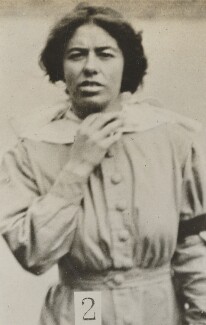
Searching for the artist Olive Hockin (or her married name, Leared) (1881-1936) in the National Portrait Gallery’s online catalogue brings up two images. These are not of Hockin’s art works, but of two silver print photographs of the artist herself.
In the first record of Hockin in the NPG’s catalogue, her image is placed in a line-up of photographs, all of women, and all given a number. Hockin is number two. The second record isolates this image of Hockin, seemingly caught off-guard, a quizzical look across her face. She appears caught in movement as she raises a hand to the neckline of her dress. It is obvious from a first glance that these are not formal studio photographs. Taken outside and captured in movement, these are in fact surveillance photographs of Hockin and fellow Suffragettes imprisoned in Holloway Prison and Manchester, made using long-lens camera equipment. These women had been identified by the London Metropolitan Police as ‘militant’ members of the Women’s Social and Political Union (WSPU) and Hockin had been imprisoned for four months in 1913 for her role in an attempted attack on the home of the then Prime Minister, David Lloyd George, and an arson attack at Roehampton golf course.

by Criminal Record Office
silver print mounted onto identification sheet, 1914
NPG x45550 (c) National Portrait Gallery
Photography had been used in prisons to record the faces of inmates since the 1870s and historians of photography have long discussed the inextricable links between the photographic image, law and the powerful evidentiary claims of the photograph. One of the tactics of resistance used by imprisoned Suffragettes was refusing to voluntarily have their photographic image taken on admission to prison, often screwing up their faces to distort the authority’s attempt to record their facial features. As a counter-tactic, Hockin and these women were photographed unknowingly as they exercised in the prison yard. These images were then gathered together to create identification sheets issued by the Criminal Record Office to art galleries and public institutions, including the National Portrait Gallery, in wake of several high profile attacks on art works in public galleries in 1913 and 1914.
Hockin’s image, therefore, did not enter the collections of the NPG as an artist – when indeed very few women artists were admitted into this national collection as the makers of, or subjects of, portraits – but as a prisoner and identified ‘militant’ because of her criminal conviction for arson and the damage of property. Her history as a Slade and Royal Academy School trained artist with a deep interest in Theosophy and mysticism (the reason why I have been researching her) has to be looked for elsewhere reminding us of the always partial, but nevertheless revealing, stories contained within catalogue records.
March 2022




